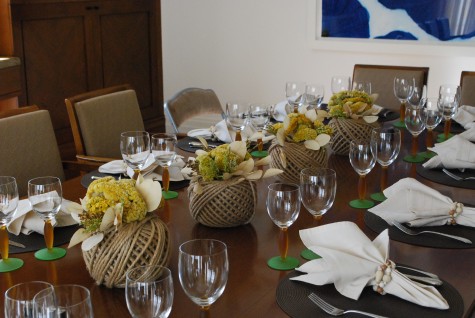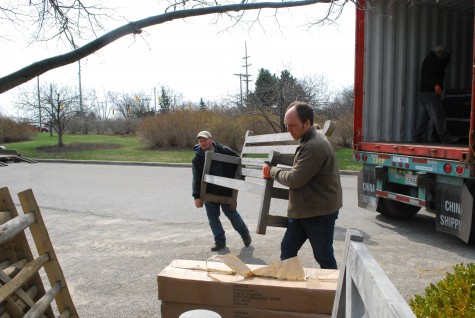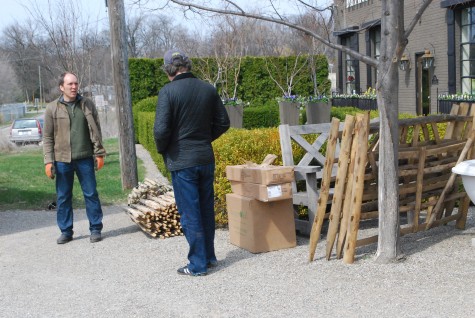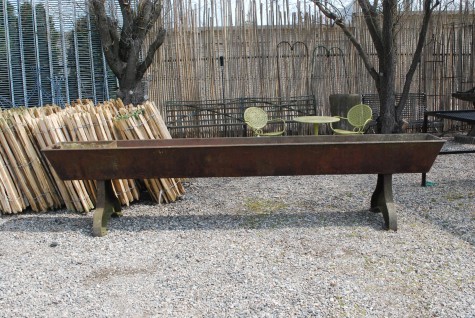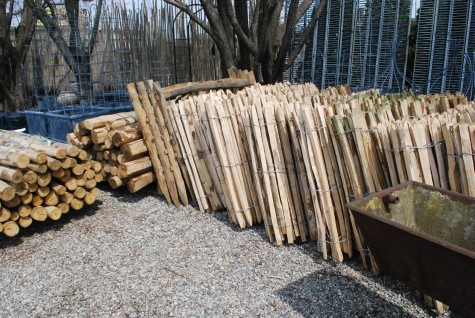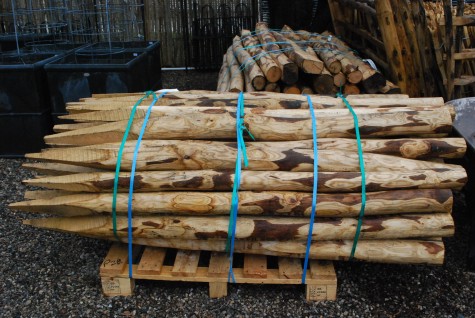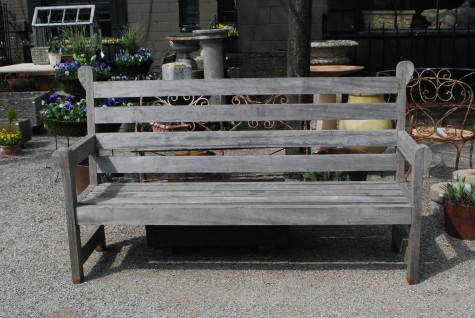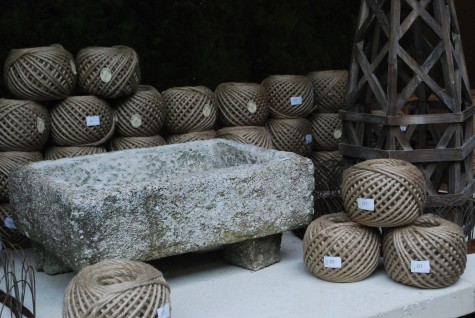 I am a fan of string, twine, thread and rope. This is a material that helps with no end of chores in the garden. The English adore twine; Nutscene is a company in England that makes string. This jute string comes in a can-just like the label says, it is pliable-meaning it will not damage tender stems. It does eventually deteriorate, but that process is slow. Pulled from the center of the spool which is contained in a can, there is no tangled mess. How you can use this jute twine with both hands free baffles me-but I am happy to let that claim pass. This jute twine is ideal for tying wayward perennial stems to a stout stake, without injuring the plant.
I am a fan of string, twine, thread and rope. This is a material that helps with no end of chores in the garden. The English adore twine; Nutscene is a company in England that makes string. This jute string comes in a can-just like the label says, it is pliable-meaning it will not damage tender stems. It does eventually deteriorate, but that process is slow. Pulled from the center of the spool which is contained in a can, there is no tangled mess. How you can use this jute twine with both hands free baffles me-but I am happy to let that claim pass. This jute twine is ideal for tying wayward perennial stems to a stout stake, without injuring the plant.
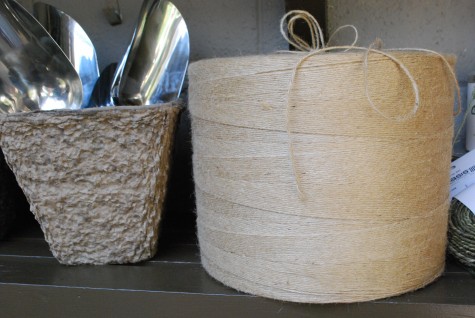 Should you have a need for thousands of yards of jute twine, Nutscene manufactures wheels of string. Pray I never have a need for this much string. But I love the look of this spool. India is the primary source for jute worldwide-the fiber comes from corchorus capsularis, or corchorus olitorius. They both are tropical annuals, from the linden family. Burlap, a staple fabric of the landscaping industry, is woven from jute. Used to bind up rootballs, jute burlap eventually rots away, permitting the roots to work their weay into the surrounding soil, and the plant to take hold. It may not be the strongest string on the planet, but it is a natural, readily available, and traditional material appreciated just as much as a strong and well made terra cotta flower pot.
Should you have a need for thousands of yards of jute twine, Nutscene manufactures wheels of string. Pray I never have a need for this much string. But I love the look of this spool. India is the primary source for jute worldwide-the fiber comes from corchorus capsularis, or corchorus olitorius. They both are tropical annuals, from the linden family. Burlap, a staple fabric of the landscaping industry, is woven from jute. Used to bind up rootballs, jute burlap eventually rots away, permitting the roots to work their weay into the surrounding soil, and the plant to take hold. It may not be the strongest string on the planet, but it is a natural, readily available, and traditional material appreciated just as much as a strong and well made terra cotta flower pot.
 Bark wire is a staple in my tool kit. I know that wire is the inner layer-I have no idea what fiber is wrapped around that wire. I am sure it is not bark-it is a rough twine of some sort. I do know that when I need some strong restraint, bark wire does the trick. Should I have a centerpiece wired in a visible way, this is my wired string of choice.
Bark wire is a staple in my tool kit. I know that wire is the inner layer-I have no idea what fiber is wrapped around that wire. I am sure it is not bark-it is a rough twine of some sort. I do know that when I need some strong restraint, bark wire does the trick. Should I have a centerpiece wired in a visible way, this is my wired string of choice.
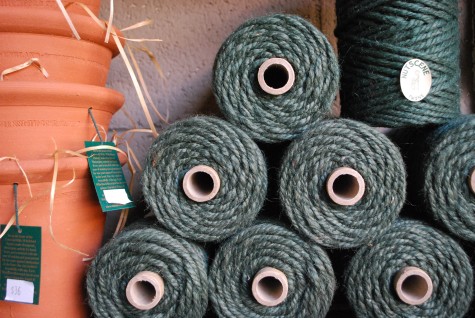 Jute dyed green is a color friendly to the garden. These spools of widely twisted jute fibers are satisfying to look at. How would I use them? You might use this twine to make a fence for peas, or wrap a package. On a twine binge, I might wrap a pot with it.
Jute dyed green is a color friendly to the garden. These spools of widely twisted jute fibers are satisfying to look at. How would I use them? You might use this twine to make a fence for peas, or wrap a package. On a twine binge, I might wrap a pot with it.
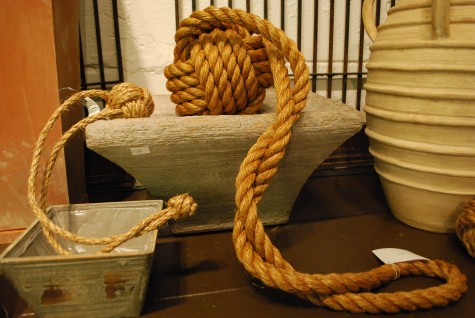 This pair of jute spheres are of vastly different sizes. The large rope wrapped sphere is a celebration of the strength that comes from many strands. It is also a testament to the maker-it is incredibly difficult to make rope conform to a small or precise shape. The technical issues aside, these are beautiful objects made from plants.
This pair of jute spheres are of vastly different sizes. The large rope wrapped sphere is a celebration of the strength that comes from many strands. It is also a testament to the maker-it is incredibly difficult to make rope conform to a small or precise shape. The technical issues aside, these are beautiful objects made from plants.
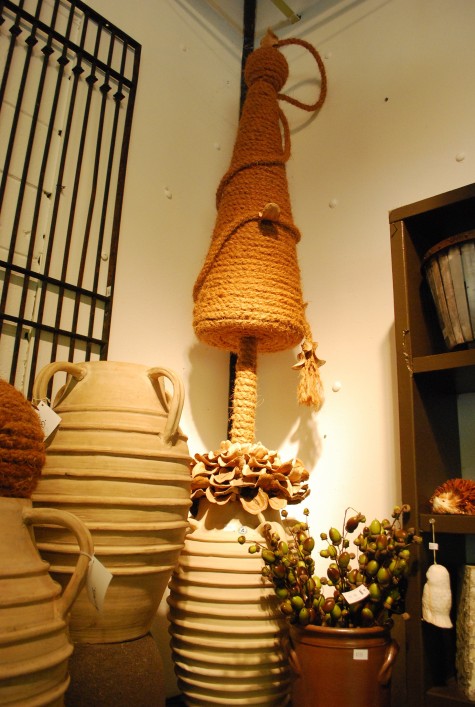 I wrapped this topiary form with its sphere finial in rope made from jute. I like the look of the horizontal bands of rope in relationship to this french beehive pot fashioned from the natural color of a local clay. This I would call the next best thing to a living plant. A sculpture from rope in a terra cotta pot brings the garden to mind.
I wrapped this topiary form with its sphere finial in rope made from jute. I like the look of the horizontal bands of rope in relationship to this french beehive pot fashioned from the natural color of a local clay. This I would call the next best thing to a living plant. A sculpture from rope in a terra cotta pot brings the garden to mind.
 I collect string. On the left, a spool of wire covered in paper. In the center, linen thread. On the right, string made from twisted paper.
I collect string. On the left, a spool of wire covered in paper. In the center, linen thread. On the right, string made from twisted paper.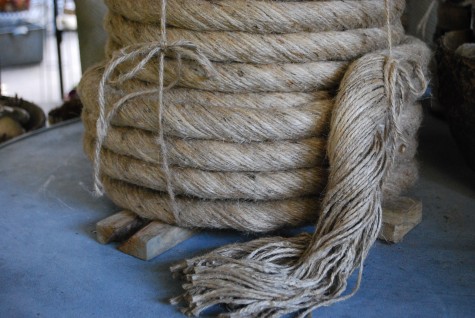 This giant wood spool is covered with a flexible jute rope comprised of many individual strands. We make bows from this rope. We hang birdhouses, and light spheres from it. We use it whole-we divide it up. We wrap tree trunks for the winter, and packages with it. The smell of natural jute is as pleasing as the smell of phlox, roses, or petunias.
This giant wood spool is covered with a flexible jute rope comprised of many individual strands. We make bows from this rope. We hang birdhouses, and light spheres from it. We use it whole-we divide it up. We wrap tree trunks for the winter, and packages with it. The smell of natural jute is as pleasing as the smell of phlox, roses, or petunias.
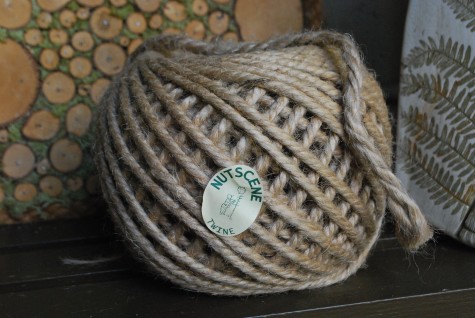 Rob bought at least a hundred balls of natural jute Nutscene twine this past spring. Most of those balls are gone. I have no idea how they got used. I do know they are beautidful objects in their own right. I had occasion to use 6 of those spools this past weekend.
Rob bought at least a hundred balls of natural jute Nutscene twine this past spring. Most of those balls are gone. I have no idea how they got used. I do know they are beautidful objects in their own right. I had occasion to use 6 of those spools this past weekend.
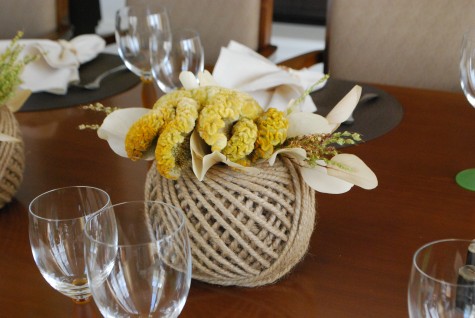 A client having her family for dinner over a holiday needed some centerpieces. I could not take my eyes off those jute spools. I worried plenty that she would not appreciate my idea about string spool vases and fall. I need not have worried.
A client having her family for dinner over a holiday needed some centerpieces. I could not take my eyes off those jute spools. I worried plenty that she would not appreciate my idea about string spool vases and fall. I need not have worried.
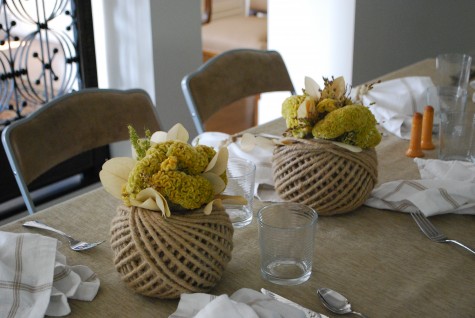 She loved the string vases, the yellow celosia, the bleached leaves, and the green broomcorn bits.
She loved the string vases, the yellow celosia, the bleached leaves, and the green broomcorn bits.
 These twine ball vases and their dry materials can stay on the table the entire fall. Natural materials have a way of fitting-even on the most formally set table.
These twine ball vases and their dry materials can stay on the table the entire fall. Natural materials have a way of fitting-even on the most formally set table.
